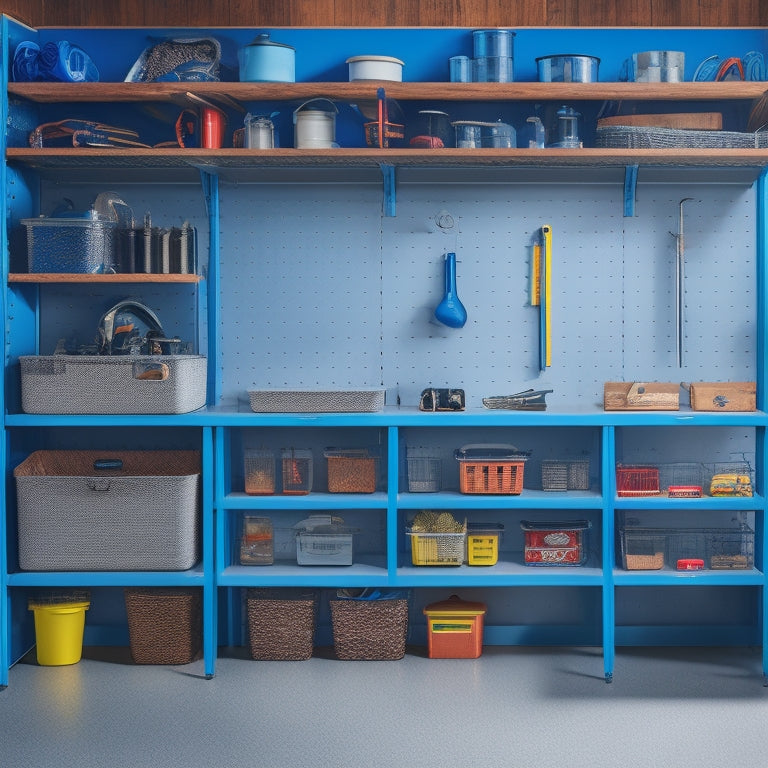
Effortless Tool Storage Solutions for Homeowners
Share
You can easily maximize your garage or workshop's storage capacity and keep your tools within easy reach by investing in a combination of adjustable shelving units, categorized tool racks, and clever wall-mounted storage solutions. This will help you categorize tools by type and function, and create a tidy workspace that boosts productivity. You'll be able to assign a spot for each tool, utilize hooks, bins, and labels, and keep tools hidden from view for a sophisticated look. By implementing these effortless tool storage solutions, you'll reveal a more efficient workshop, and discover even more innovative ways to streamline your tool organization.
Key Takeaways
• Invest in adjustable shelves and cabinets to maximize garage storage space and keep tools organized.
• Categorize and label tools by type and function to ensure easy access and efficient use.
• Utilize wall space with shelves, bins, and magnetic strips to store tools and equipment.
• Opt for portable tool storage options like tool bags and compact toolboxes for easy transport.
• Assign a designated spot for each tool and implement regular decluttering to maintain a tidy workspace.
Maximizing Garage Storage Space
You likely spend a significant amount of time in your garage, whether it's for DIY projects, parking your car, or simply storing seasonal decorations, so maximizing the storage space is vital to keep clutter at bay and make the most of this valuable area.
To achieve this, consider investing in shelving solutions that cater to your specific needs. For instance, adjustable shelves can accommodate tools and equipment of varying sizes, while fixed shelves provide a stable surface for heavier items. Don't forget to organize your tool chest by categorizing and labeling each drawer, ensuring you can quickly locate the tool you need.
Take advantage of overhead storage by installing racks or hooks to hang bikes, luggage, or infrequently used items. This will free up floor space and reduce clutter. If you're handy, create DIY tool racks using reclaimed wood or repurposed materials. These can be mounted on walls or ceilings, providing additional storage for tools and accessories.
Organizing Tools by Category
When you're organizing tools by category, you'll want to start by grouping similar tools together.
You'll need to decide on a method for categorizing your tools, such as separating hand tools from power tools or creating categories based on the tasks they're used for.
Tool Grouping Methods
By categorizing tools into distinct groups, homeowners can create a logical and efficient system that streamlines their workflow and reduces frustration. This approach allows you to focus on the task at hand, rather than wasting time searching for scattered tools.
Start by grouping similar tools together, such as all your screwdrivers in one section of your tool cabinet arrangement. Next, organize your tool drawer by separating fasteners, pliers, and wrenches into separate compartments.
Consider a tool rack display for hanging tools like hammers, levels, and saws, keeping them easily accessible and visible. Don't forget to label each section and compartment using tool box labeling, ensuring you can quickly identify where each tool belongs.
By implementing these tool grouping methods, you'll be able to find what you need in seconds, saving you time and energy. This system also encourages you to maintain your tools, as you'll be more likely to return them to their designated spot after use.
With a well-organized tool storage system, you'll be more productive, efficient, and prepared to tackle any project that comes your way.
Hand Tool Segregation
Your hand tool collection falls into distinct categories, each requiring a unique storage approach to maximize accessibility and convenience.
Segregating your hand tools by category is an effective way to make sure you can quickly find what you need when you need it. For instance, you can store wrenches and pliers in a dedicated section of your tool box, while screwdrivers and hammers go in another. This segregation allows you to see what you have at a glance, making it easier to identify what's missing or what needs to be replenished.
In your tool cabinet, you can create separate drawers or compartments for different categories of hand tools. For example, you can designate one drawer for measuring tools like levels and calipers, and another for cutting tools like saws and utility knives.
By organizing your hand tools in this way, you'll save time and reduce frustration when working on projects. Plus, you'll be able to maintain your tools more effectively, which can help extend their lifespan.
Power Tool Classification
You'll find that organizing power tools into categories is just as important as segregating hand tools, as it enables you to pinpoint the right tool for the task at hand and prevents a jumbled mess in your workshop or garage.
This classification system ensures that you can quickly locate the required tool, saving you time and energy. One effective way to categorize power tools is by their function, such as drilling, sawing, or sanding. You can also group them by the type of project they're used for, like woodworking, metalworking, or automotive.
Proper power tool classification also facilitates tool maintenance and safety. When your tools are organized, you're more likely to perform regular maintenance tasks, such as cleaning and lubricating, which extends their lifespan. Additionally, a well-organized workshop reduces the risk of accidents, as you're less likely to trip over cords or misplace tools.
Utilizing Vertical Wall Space
Frequently, homeowners overlook the valuable storage potential of their walls, which can be leveraged to maximize space and keep tools organized. By utilizing vertical wall space, you can create a more efficient and clutter-free workspace. Here are some ideas to get you started:
-
Hanging baskets: Suspend hanging baskets from the ceiling or a wall to store lightweight tools, accessories, or supplies.
-
Magnetic strips: Install magnetic strips on a metal wall or cabinet to store small metal tools, such as wrenches, pliers, or screwdrivers.
-
Wall-mounted cabinets: Install wall-mounted cabinets or shelves to store larger tools, equipment, or supplies, keeping them out of the way but still accessible.
- Shelves with bins: Add shelves with bins or containers to store small items, such as nuts, bolts, or other fasteners, keeping them organized and easy to find.
Portable Tool Storage Options
While maximizing vertical wall space is important, having portable tool storage options allows you to carry your tools and supplies with you to different work areas or job sites, providing flexibility and convenience.
You can opt for tool bags that offer versatility in terms of size, material, and compartments. They can be easily carried or slung over your shoulder, making them perfect for small to medium-sized projects.
If you need more storage capacity, consider compact toolbox options that can be easily transported in your vehicle or on foot. For larger projects or heavier tools, rolling tool carts and mobile tool organizers are ideal. These provide ample storage space and can be easily maneuvered around the job site.
Look for ones with sturdy frames, smooth-rolling wheels, and adjustable compartments to keep your tools organized and within reach. By having these portable tool storage options, you'll be able to work more efficiently and effectively, no matter where the project takes you.
Customizing Tool Pegboards
With a pegboard as your foundation, customizing it with hooks, bins, and accessories tailored to your specific toolset and workflow can greatly boost storage capacity and accessibility. By doing so, you'll be able to quickly locate and retrieve the tools you need, saving you time and effort.
Here are some ideas to get you started:
-
Color code your tools: Assign a specific color to each tool category (e.g., blue for hand tools, red for power tools) and use corresponding hooks and bins to create a visually organized system.
-
Use tool shadowing: Create a silhouette of each tool on the pegboard using a marker or sticker, making it easy to identify where each tool belongs.
-
Integrate with your tool drawer organization: Consider the layout of your tool drawers and cabinet setup when designing your pegboard, ensuring a seamless workflow between storage areas.
- Add specialized accessories: Incorporate bins for small parts, hooks for cords, or a magnetic strip for metal tools to maximize storage capacity and keep your workspace tidy.
Decluttering Small Workshops
You'll be amazed at how much more efficiently you can work in a small workshop once you've decluttered the space and established a functional workflow. A cluttered workshop can be overwhelming, making it difficult to focus on the task at hand.
To get started, sort items into three categories: keep, donate/sell, and discard. Be ruthless – if you haven't used it in the past year, it's likely you won't miss it. Next, assign a home for each item you're keeping, using workshop organization and space saving solutions like wall-mounted shelves, bins, and hooks. Consider implementing decluttering tips like the 'one in, one out' rule to maintain your newly organized space.
To maximize storage, utilize storage hacks like labeling bins and using vertical space. Install a pegboard or a slatwall to hang frequently used tools, keeping them within easy reach.
Creating a Tool Station
By designating a specific area as a tool station, you can centralize your most frequently used tools and equipment, streamlining your workflow and saving time. This dedicated space will help you stay organized and focused, making it easier to tackle DIY projects and other tasks.
When creating a tool station, consider the following essential elements:
-
Tool Organization: Assign a designated spot for each tool, using hooks, bins, and labels to keep them within easy reach.
-
Work Surface: Install a robust workbench or countertop to provide a comfortable and stable area for working on projects.
-
Power Source: Ensure convenient access to power outlets and consider adding a USB charging station for your devices.
- Lighting: Install task lighting, such as under-cabinet lights or a pendant light, to illuminate your workspace and reduce eye strain.
Hidden Tool Storage Ideas
Now that you've designated a tool station, it's time to explore clever ways to stash tools and equipment out of sight, freeing up valuable space and adding a touch of sophistication to your workshop or garage.
One of the most innovative hidden tool storage ideas is the secret compartment. You can create a hidden compartment in a workbench, cabinet, or even a wall. This will allow you to store valuable or sensitive tools and equipment out of sight, keeping them safe from prying eyes or curious hands.
Another clever idea is to utilize under-cabinet space. You can install a slide-out drawer or a pull-down rack under your cabinets, providing easy access to frequently used tools while keeping them hidden from view.
Frequently Asked Questions
How Do I Prevent Tools From Getting Rusty in Storage?
To prevent tools from getting rusty in storage, you'll want to employ rust prevention techniques like applying a rust-inhibiting coating and storing them in a dry, well-ventilated area using proper storage methods like airtight containers or silicone bags.
Can I Use a Pegboard in a Humid Environment?
'You're wise to wonder if a pegboard can thrive in a humid environment; the answer is yes, if you provide proper ventilation and take rust prevention measures, like using rust-resistant hooks and coatings, to keep your tools safe and secure.'
Are There Tool Storage Solutions for Left-Handed People?
You'll find left-handed tool organizers designed specifically for your needs, offering customized storage options that cater to your unique grip and workflow, ensuring efficient tool access and reduced frustration.
How Often Should I Clean and Maintain My Tool Storage?
You should establish a regular cleaning schedule and maintenance routine to prevent rust and keep your tools organized, ensuring they remain in top condition and ready for your next project.
Can I Repurpose Old Furniture for Tool Storage?
You can breathe new life into old furniture by repurposing it for tool storage, using DIY hacks and organizing tips to create creative solutions that maximize space and offer space-saving ideas for your tools.
Related Posts
-

Small Storage Bins to Maximize Shelf Space
When maximizing shelf space, you want to make the most of every inch. Small storage bins are the answer, but choosing...
-

Small Shelving Options for Tight Spaces
You're surrounded by tight spaces in your home, and you need clever shelving solutions that optimize storage without ...
-

Heavy-Duty Commercial Rolling Shelving Racks
You need heavy-duty commercial rolling shelving racks that optimize your storage capacity, streamline operations, and...


